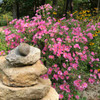Aster novae-angliae 'Honeysong Pink' (Symphyotrichum) - NEW ENGLAND ASTER 'HONEYSONG PINK'
One of the best performing asters in the 2003-2009 Chicago Botanic Garden trials!
Bright deep pink flowers, good flower coverage, manageable size, usually without flopping and opening.
Excellent resistance to leaf spots (better than some new cultivars).
We confirm all of that above. For unknown reasons not commonly available!
The “legs” of New England Asters always loose leaves, so it's best to plant them at the back of the flower bed where medium tall plants can cover the bare stems. New England Asters can become floppy, especially with too much moisture on too rich soil, so you can plant other taller perennials for stalk support or provide the “Chelsea Chop” (cut back 1/3 to ½ of the stems at the end of May/beg. June, causing the plants to stay shorter and bloom even more, with slightly smaller flowers that appear a bit later than usual).
Long-lived and black walnut tolerant perennial.
Blooming Time: August - September
Size: 3'-3.5' tall x 2' wide (depend on moisture and fertility)
USDA Zones: 4 to 9
Culture: sun, half sun, half shade, average soil, loam, clay soil, dry clay. Avoid waterlogged and poorly drained soils
Moisture Needs: medium-wet to medium-dry, tolerates droughts
Origin: The wild form is native to most states in the US except Arizona, Idaho, Nevada, Texas and Florida.
Deer/Rabbit Resistant: yes/yes
Attracts Butterflies or Pollinators: yes / yes, but less than the species
Attracts Hummingbirds: no
Pot Size: square 3.5" x 5" deep pot
Plant combinations: Versatile plant, can be used in cottage gardens, sunny borders, prairies, medium moist meadows, butterfly gardens, pollinator gardens, rain gardens or for naturalization. It looks good with Agastache 'Blue Fortune', Aster ericoides, Asclepias, Baptisia, Helenium, Rudbeckia (fulgida, maxima, subtomentosa), Monarda (fistulosa, didyma, x hybrida), Iris, Liatris, Phlox paniculata cultivars, Silphium, Salvia, or grasses like Andropogon gerardii, Panicum virgatum, and Sorghastrum.
Pictures copyright : US Perennials

Aster novae-angliae 'Honeysong Pink' (Symphyotrichum) - NEW ENGLAND ASTER 'HONEYSONG PINK'
One of the best performing asters in the 2003-2009 Chicago Botanic Garden trials!
Bright deep pink flowers, good flower coverage, manageable size, usually without flopping and opening.
Excellent resistance to leaf spots (better than some new cultivars).
We confirm all of that above. For unknown reasons not commonly available!
The “legs” of New England Asters always loose leaves, so it's best to plant them at the back of the flower bed where medium tall plants can cover the bare stems. New England Asters can become floppy, especially with too much moisture on too rich soil, so you can plant other taller perennials for stalk support or provide the “Chelsea Chop” (cut back 1/3 to ½ of the stems at the end of May/beg. June, causing the plants to stay shorter and bloom even more, with slightly smaller flowers that appear a bit later than usual).
Long-lived and black walnut tolerant perennial.
Blooming Time: August - September
Size: 3'-3.5' tall x 2' wide (depend on moisture and fertility)
USDA Zones: 4 to 9
Culture: sun, half sun, half shade, average soil, loam, clay soil, dry clay. Avoid waterlogged and poorly drained soils
Moisture Needs: medium-wet to medium-dry, tolerates droughts
Origin: The wild form is native to most states in the US except Arizona, Idaho, Nevada, Texas and Florida.
Deer/Rabbit Resistant: yes/yes
Attracts Butterflies or Pollinators: yes / yes, but less than the species
Attracts Hummingbirds: no
Pot Size: square 3.5" x 5" deep pot
Plant combinations: Versatile plant, can be used in cottage gardens, sunny borders, prairies, medium moist meadows, butterfly gardens, pollinator gardens, rain gardens or for naturalization. It looks good with Agastache 'Blue Fortune', Aster ericoides, Asclepias, Baptisia, Helenium, Rudbeckia (fulgida, maxima, subtomentosa), Monarda (fistulosa, didyma, x hybrida), Iris, Liatris, Phlox paniculata cultivars, Silphium, Salvia, or grasses like Andropogon gerardii, Panicum virgatum, and Sorghastrum.
Pictures copyright : US Perennials







